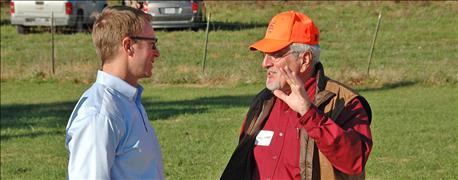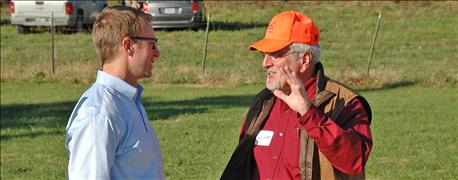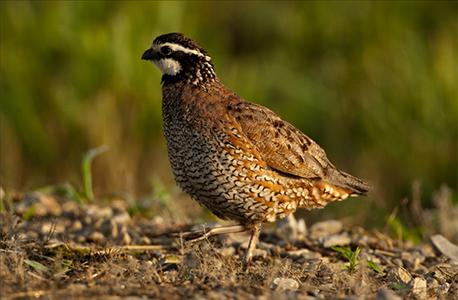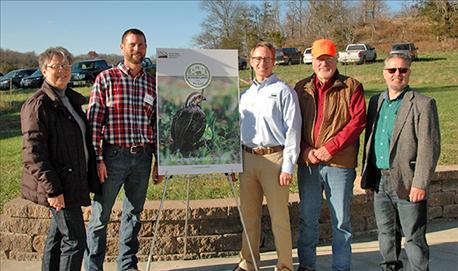
Montgomery County farmer Gary Heldt may soon see a new resident in his pastures and along the edge of his woods. It will be near to the ground, so Heldt, along with his wife, Patty, may need to be patient and look a little longer. Still, it will be worth the wait.
Heldt's farm is part of 11 new projects that add northern bobwhite quail to farms, ranches and forests.
According to the Missouri Department of Conservation, the northern bobwhite quail is still fairly common in grasslands, shrubby pastures and hedgerows, and on woodland edges. However, populations have been declining in recent decades, due to habitat loss and harsh weather during winter and nesting season.

TALKING QUAIL: Jason Weller, NRCS chief (left), and landowner Gary Heldt talk about adding northern bobwhite quail to Heldt's farm in Montgomery County. (Photo courtesy of NRCS)
Jason Weller, USDA Natural Resources Conservation Service chief, visited the Heldt farm near New Florence to announce the new initiative that is helping farmers enhance habitat to aid in the bobwhite’s recovery.
“Agriculture and wildlife both thrive together through landscape conservation,” J.R. Flores, NRCS state conservationist in Missouri, said in a news release. “We’re working with farmers to make bobwhite-friendly improvements on working lands that will help the species and benefit farming operations.”
The habitat
Farmers in Missouri are part of the project that targets grasslands: where NRCS is working with producers to replace non-native grasses with native grasses, forbs and legumes that benefit bobwhite and other wildlife, while creating alternative healthy grazing options for livestock. Other states included in the bobwhite restoration project include Virginia, Arkansas, Illinois, Indiana, North Carolina, Ohio and Kentucky.

Northern bobwhite quail
When habitat is restored for the bobwhite, NRCS researchers find that other species benefit, including turkeys, deer, rabbits and many different songbirds. The agency says it uses the bobwhite and other wildlife as indicators of the health of the ecosystem at large.
With more than two-thirds of the continental United States under private ownership, according to the NRCS, wildlife depends heavily on working lands for habitat and food. Projects focus on declining species that have needs compatible with agricultural practices and rural land management, and that can benefit from conservation on private lands.

WILDLIFE PARTNERSHIP: NRCS credits partnerships with farmers for helping increase wildlife in Missouri. The Heldt family will be part of the latest project to add northern bobwhite quail to the eastern part of the state. Picture here are Patty Heldt (from left), Chris Heldt, NRCS Chief Jason Weller, Gary Heldt and NRCS state conservationist J.R. Flores. (Photo courtesy of NRCS)
The project
The bobwhite restoration project is through NRCS Working Lands for Wildlife, the agency’s effort to help producers restore and protect habitat for declining species on farms and ranches. So far, WLFW has helped landowners restore 6.7 million acres of habitat for seven target species. “The future of wildlife, agriculture and rural ways of life depends on our collective ability to transfer our Working Lands for Wildlife model to more species and working landscapes,” Flores says.
Through WLFW, NRCS invests in programs where conservation returns are highest, and measures how wildlife respond to management activities to refine conservation efforts.
NRCS provides technical and financial assistance to help farmers and ranchers adopt a variety of conservation practices on their land. NRCS staff help producers with a conservation plan and provide funding to cover part of the costs for adopting the practices. These practices are designed to benefit both the wildlife species and the agricultural operation.
About the Author(s)
You May Also Like






